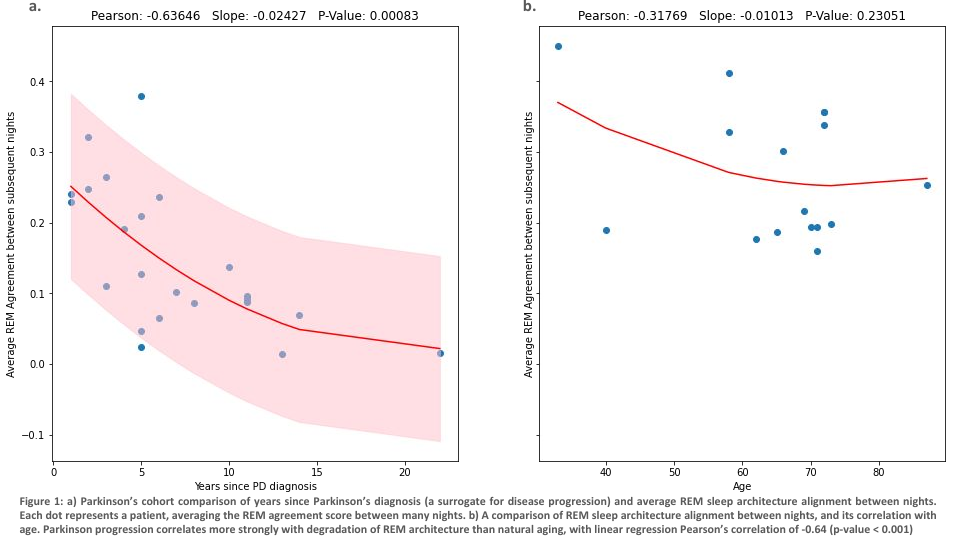Category: Parkinson's Disease: Non-Motor Symptoms
Objective: Our study finds that the effects of Parkinson’s disease on impairing normal REM sleep far surpass those of the RBD subpopulation alone. In fact, the majority of Parkinson’s patients in our cohort have impaired REM sleep architecture compared to age-matched controls. This impairment appears as a loss of REM cyclic structure as the disease progresses (p<0.001).
Background: Parkinson’s disease (PD) is known to be correlated with a number of sleep conditions, including excessive daytime sleepiness (EDS), sleep apnea, insomnia, and REM Sleep Behavior Disorder (RBD). RBD, in particular, a condition characterized by a lack of muscular paralysis in Rapid Eye Movement (REM) sleep, is widely considered as an early indicator of PD.
Method: We report the results of a longitudinal sleep study following a cohort of participants for up to one year. In total, we gathered over 10,000 nights of sleep data from 50 individuals, 25 of whom are at varying stages of PD, 9 are LRKK2 carriers who have no PD diagnosis, and the rest are age-matched control individuals. Using a novel Expectation-Maximization algorithm, we analyze the REM sleep cyclic architecture over time for each individual.
Results: Our results show that the REM cyclic architecture deteriorates significantly in individuals with PD compared to their age-matched controls. Individuals with LRKK2 mutation and no PD diagnosis exhibit a more consistent REM architecture than those with PD but less so than the control individuals. Interestingly, this impairment in the cyclic structure of REM sleep increases with PD disease duration (Pearson correlation is 0.64 with p < 0.001). Meanwhile, the control group had no significant correlation between REM cyclic architecture and age, showing further evidence that the destruction of REM architecture is beyond normal aging and characteristic of individuals with Parkinson’s disease.
Conclusion: It is suspected that sleep problems in PD, specifically issues pertaining to REM such as RBD, are a result of brainstem neurodegeneration. Due to its anatomical proximity to the basal ganglia, REM impairment could provide an early indicator of PD and a progression marker of the disease. Further investigation of this relationship between REM architecture deterioration and disease progression within early diagnoses and prodromal populations is proposed to further assess the strength of this biomarker.
Figure 1
To cite this abstract in AMA style:
A. Mirzazadeh, R. Levy, H. Rahul, R. Dorsey, A. Videnovic, D. Katabi. Impairment of REM Sleep Architecture: A Potential Biomarker for Parkinson’s Progression [abstract]. Mov Disord. 2024; 39 (suppl 1). https://www.mdsabstracts.org/abstract/impairment-of-rem-sleep-architecture-a-potential-biomarker-for-parkinsons-progression/. Accessed May 9, 2025.« Back to 2024 International Congress
MDS Abstracts - https://www.mdsabstracts.org/abstract/impairment-of-rem-sleep-architecture-a-potential-biomarker-for-parkinsons-progression/

